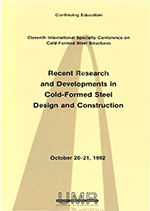Location
Saint Louis, Missouri
Session Dates
20 Oct 1992
Abstract
The paper describes a test program on purlin-sheeting systems for which the sheeting was screw fastened to the purlins. The test program simulates downwards loading. Z-section purlins were tested in three span continuous lapped configurations. The test purlins were supported by a range of bridging (bracing) members ranging from no bracing to one brace per span. The test results are compared with the design values computed using the Australian Cold-Formed Steel Structures Standard (AS1538-1988). The Australian Standard design is based on a flexural-torsional buckling analysis which may include the restraint from attached sheeting.
Department(s)
Civil, Architectural and Environmental Engineering
Research Center/Lab(s)
Wei-Wen Yu Center for Cold-Formed Steel Structures
Meeting Name
11th International Specialty Conference on Cold-Formed Steel Structures
Publisher
University of Missouri--Rolla
Document Version
Final Version
Rights
© 1992 University of Missouri--Rolla, All rights reserved.
Document Type
Article - Conference proceedings
File Type
text
Language
English
Recommended Citation
Celeban, Michael; Healy, Chris; and Hancock, Gregory J., "Tests of Continuous Purlins under Downwards Loading" (1992). CCFSS Proceedings of International Specialty Conference on Cold-Formed Steel Structures (1971 - 2018). 4.
https://scholarsmine.mst.edu/isccss/11iccfss/11iccfss-session3/4
Tests of Continuous Purlins under Downwards Loading
Saint Louis, Missouri
The paper describes a test program on purlin-sheeting systems for which the sheeting was screw fastened to the purlins. The test program simulates downwards loading. Z-section purlins were tested in three span continuous lapped configurations. The test purlins were supported by a range of bridging (bracing) members ranging from no bracing to one brace per span. The test results are compared with the design values computed using the Australian Cold-Formed Steel Structures Standard (AS1538-1988). The Australian Standard design is based on a flexural-torsional buckling analysis which may include the restraint from attached sheeting.



